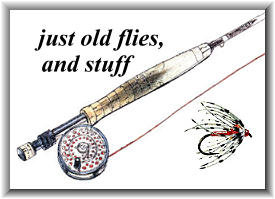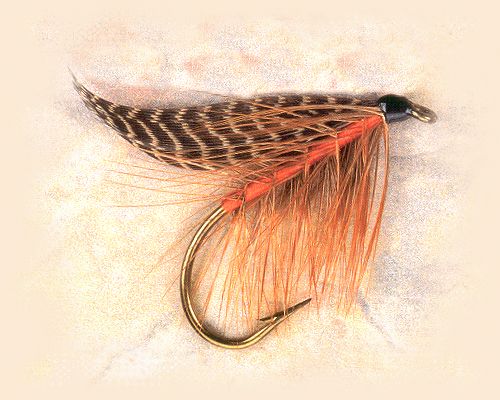Quoting Mary Orvis Marbury, from Favorite Flies and
Their Histories, "The Queen of the Water is credited
to both Professor John Wilson ("Christopher North") and his
brother, the naturalist, Professor James Wilson. It is claimed
by old fishermen that the Professor fly was made originally
without the bit of scarlet ibis feather representing the
stylets of an insect, and many experienced fishermen of
to-day cut these fibres of ibis feather off, while others
consider the fly useless without them. If, as is asserted,
the Professor was first made without them, there was then
very little difference between the Professor and the present
Queen of the Water, except that the body of the latter is
of a darker shade of yellow, almost an orange, and the hackle
is wound the entire length of the body ; therefore it is
reasonable to presume that the two are only variations of
the original fly, that in time came to be known as distinct
patterns.
The body of the Queen of the Water, being a palmer or
caterpillar body, is not as durable as the plain bodies,
but in its praise the following, written by Miss Sara J.
McBride, who was a most careful investigator, will apply :
"The larvae of the moths is a favorite fish food, and
consequently a successful bait. Hibernating larvae are
drawn from their retreats in warm spring days, and continue
the pilgrimage they commenced the previous fall. In their
wild journeyings on and on before spinning the pupal-shroud,
they fall victims in attempting to cross streams. Hairy
caterpillars feeding on the trees are blown off by the winds,
or their silken thread is broken, and they hang under the
leaves in shelter from the rain. Imitations of these, known
to the American by the familiar term hackles, and to the accurate
inhabitant of the British Isles by the correct name of palmers,
are to be used after winds or during rain-storms, also that
compromise between larvae and imago known as the 'hackle fly.'
Bristling with feet its entire length, and graced with a pair
of wings, it offers a double attraction to the fish. No bait
has ever been used that has given the general satisfaction
of this anomaly. To look at it with the eye of the naturalist,
one doubts the wit or widsom of the fish that takes it, and
concludes there are comparative degrees of saneness beneath
the ripple of the wave."
History has proved, however, that the queens who attracted
and gathered armies of followers are most wondered at for
their bewildering combinations and contradictions ; this
little atom, then, with its inconsistency and its power
to charm and draw the inhabitant of the "cool deep," is
fittingly named the Queen of the Water."
Recipe for Queen of the Water
(as tied by Ray Bergman)
Credits: Text from Favorite Flies and
Their Histories published by Lyons Press. Photo and
dressing from Forgotten Flies, published by
Complete Sportsman.
|



